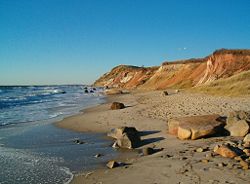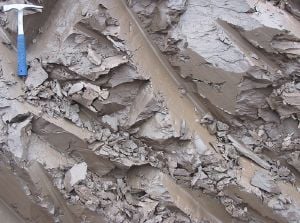Difference between revisions of "Clay" - New World Encyclopedia
| Line 1: | Line 1: | ||
| + | {{Images OK}}{{Submitted}} | ||
:{{otheruses}} | :{{otheruses}} | ||
[[Image:Gay head cliffs MV.JPG|right|thumb|250px|The Gay Head cliffs in [[Martha's Vineyard]] are made almost entirely of clay.]] | [[Image:Gay head cliffs MV.JPG|right|thumb|250px|The Gay Head cliffs in [[Martha's Vineyard]] are made almost entirely of clay.]] | ||
Revision as of 15:51, 25 September 2006
- For other uses, see Clay (disambiguation).
Clay is a term used to describe a group of hydrous aluminium phyllosilicate (phyllosilicates being a subgroup of silicate minerals) minerals that are typically less than 2 μm (micrometres) in diameter. Clay consists of a variety of phyllosilicate minerals rich in silicon and aluminium oxides and hydroxides which include variable amounts of structural water. Clays are generally formed by the chemical weathering of silicate-bearing rocks by carbonic acid but some are formed by hydrothermal activity. Clays are distinguished from other small particles present in soils such as silt by their small size, flake or layered shape, affinity for water and high plasticity index.
Depending upon academic source, there are three or four main groups of clays: kaolinite, montmorillonite-smectite, illite, and chlorite (the latter group is not always considered a part of the clays and is sometimes classified as a separate group within the phyllosilicates). There are about thirty different types of 'pure' clays in these categories but most 'natural' clays are mixtures of these different types, along with other weathered minerals.
Montmorillonite, with a chemical formula of (Na,Ca)0.33(Al,Mg)2Si4O10(OH)2·nH2O, is typically formed as a weathering product of low silica rocks. Montmorillonite is a member of the smectite group and a major component of bentonite.
Varve (or varved clay) is clay with visible annual layers, formed by seasonal differences in erosion and organic content. This type of deposit is common in former glacial lakes from the ice age.
Quick clay is a unique type of marine clay, indigenous to the glaciated terrains of Norway, Canada, and Sweden. It is a highly sensitive clay, prone to liquefaction which has been involved in several deadly landslides.
Clay minerals
Clay minerals are hydrous aluminum phyllosilicates, sometimes with variable amounts of iron, magnesium, alkali metals, alkaline earths and other cations. Clays have structures similar to the micas and therefore form flat hexagonal sheets. Clay minerals are common weathering products and low temperature hydrothermal alteration products. Clay minerals are very common in fine grained sedimentary rocks such as shale, mudstone and siltstone and in fine grained metamorphic slate and phyllite.
Clay minerals include the following groups:
- Kaolinite group which includes the minerals kaolinite, dickite, halloysite and nacrite.
- Some sources include the serpentine group due to structural similarities (Bailey 1980).
- Smectite group which includes pyrophyllite, talc, vermiculite, sauconite, saponite, nontronite and montmorillonite.
- Illite group which includes the clay-micas. Illite is the only common mineral.
- Chlorite group includes a wide variety of similar minerals with considerable chemical variation.
Structure
Like all phyllosilicates, clay minerals are characterised by two-dimensional sheets of corner sharing SiO4 and AlO4 tetrahedra. Each tetrahedron shares 3 of its vertex oxygen atoms with other tetrahedra. The fourth vertex is not shared with another tetrahedron and all of the tetrahedra "point" in the same direction (i.e. all of the unshared vertices are on the same side of the sheet). These tetrahedral sheets have the chemical composition (Al,Si)3O4.
In clays the tetrahedral sheets are always bonded to octahedral sheets formed from small cations, such as aluminium or magnesium, coordinated by six oxygen atoms. The unshared vertex from the tetrahedral sheet also form part of one side of the octahedral sheet but an additional oxygen atom is located above the gap in the tetrahedral sheet at the center of the six tetrahedra. This oxygen atom is bonded to a hydrogen atom forming an OH group in the clay structure. Clays can be categorised depending on the way that tetrahedral and octahedral sheets are packaged into layers. If there is only one tetrahedral and one octahedral group in each layer the clay is known as a 1:1 clay. The alternative, known as a 2:1 clay, has two tetrahedral sheets with the unshared vertex of each sheet pointing towards each other and forming each side of the octahedral sheet.
Depending on the composition of the tetrahedral and octahedral sheets, the layer will have no charge, or will have a net negative charge. If the layers are charged this charge is balanced by interlayer cations such as Na+ or K+. In each case the interlayer can also contain water. The crystal structure is formed from a stack of layers interspaced with the interlayers.
Historical and modern uses of clay
Clay is plastic when wet, which means it can be easily shaped. When dry, it becomes firm and when subject to high temperature, known as firing, permanent physical and chemical reactions occur which, amongst other changes, causes the clay to be hardened. A fireplace or oven specifically designed for hardening clay is called a kiln. These properties make clay an ideal substance for making durable pottery items, both practical and decorative, with different types of clay and firing conditions giving earthenware, stoneware and porcelain. Early humans discovered the useful properties of clay in prehistoric times, and one of the earliest artifacts ever uncovered is a drinking vessel made of sun-dried clay. Depending on the content of the soil, clay can appear in various colors, from a dull gray to a deep orange-red.
Clays sintered in fire were the first ceramic, and remain one of the cheapest to produce and most widely used materials even in the present day. Bricks, cooking pots, art objects, dishware and even musical instruments such as the ocarina are all made with clay. Clay is also used in many industrial processes, such as paper making, cement production, pottery, and chemical filtering.
See also
ReferencesISBN links support NWE through referral fees
- Clay mineral nomenclature American Mineralogist.
- Clay Mineral Group Mineral Galleries Accessed Jan. 2, 2006
- Bailey, S. W., 1980, Summary of recommendations of AIPEA nomenclature committee on clay minerals, American Mineralogist Volume 65, pages 1-7. Accessed Jan. 2, 2006
External links
- WHO (2005), Bentonite, kaolin, and selected clay minerals, number 231 in ‘Environmental Health Criteria’, WHO. Available from: http://www.who.int/entity/ipcs/publications/ehc/ehc231.pdf
- Clay used as building material. Building with clay
Credits
New World Encyclopedia writers and editors rewrote and completed the Wikipedia article in accordance with New World Encyclopedia standards. This article abides by terms of the Creative Commons CC-by-sa 3.0 License (CC-by-sa), which may be used and disseminated with proper attribution. Credit is due under the terms of this license that can reference both the New World Encyclopedia contributors and the selfless volunteer contributors of the Wikimedia Foundation. To cite this article click here for a list of acceptable citing formats.The history of earlier contributions by wikipedians is accessible to researchers here:
The history of this article since it was imported to New World Encyclopedia:
Note: Some restrictions may apply to use of individual images which are separately licensed.


